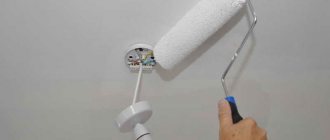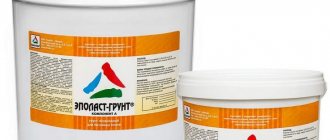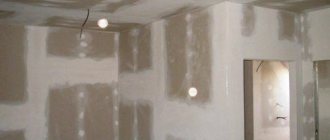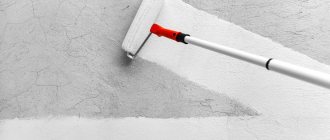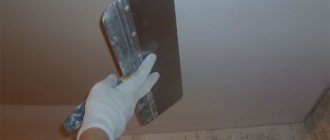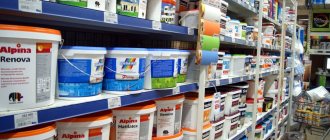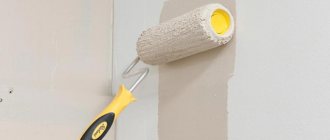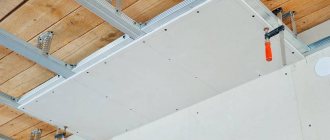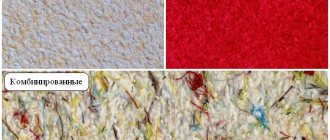Purpose
Why is a primer needed? This question is asked not only by beginners in the construction process, but also by very experienced craftsmen. The purpose of the liquid is as follows:
- Strengthening the concrete surface. Liquid consistency allows the product to be easily absorbed. The water contained in it gradually evaporates under the influence of positive temperatures, leaving solid particles in the concrete. The latter are responsible for increasing the strength of the ceiling surface.
- Increased adhesion. The primer creates a film on the ceiling that improves the adhesion of the slab and finishing material.
Some types of the product have bactericidal properties. After their application, the ceiling surface becomes resistant to mold and the development of fungal spores. This quality is invaluable for rooms where children, as well as people with diseases of the respiratory system, stay for a long time.
The question often arises whether it is necessary to prime the ceiling before painting. The main purpose of the product is to prevent moisture from being absorbed by the ceiling surface. Skipping a liquid treatment step when painting will result in more coats being required to evenly cover the entire surface. Even after applying putty, it is impossible to exclude the possibility that the paint will begin to crumble after some time.
What are the types of primer mixtures?
Materials for processing ceiling tiles have different compositions depending on the type of base surface. It is also important to consider the type of room. For example, acrylic, alkyd primer, as well as a product with a mineral base, are the best choice for rooms in a house, apartment, or office.
Acrylic primer can have different compositions, which allows it to be divided into several types.
Impregnating
This product is needed when working with loose base. The loose structure of plaster mixtures and putty allows the product containing latex to penetrate to a depth of 10 cm. The result is a monolithic base that will last quite a long time.
Strengthening
Doesn't really penetrate into the base. Its purpose is to tie those parts of the base that hold weakly. This composition is used, for example, if the ceiling is covered with plaster with a fine fraction. This primer is also needed if you need to strengthen minor cracks. Both of these types of primers are indicated for working with surfaces that have previously been whitewashed.
Adhesive
Due to the presence of acrylic in the composition, it creates a film on the base. In the future, this allows you to significantly save on finishing materials for subsequent work. This type of primer can be easily combined with almost any paint. Even putty is much easier to apply.
How long does it take for any type of acrylic primer to dry? On average, from 6 to 12 hours. The exact time depends on what the foundation was.
Primer technology
Before priming, the first thing you need to prepare the surface . For this purpose, all dirt and particles of the solution are removed. The previous coating (wallpaper, chalk, glue) must be carefully scraped off.
Preparing the primer
After preparing the base, we begin the primer. Shake the prepared solution well and pour it into the tray. The concentrated primer is diluted according to the manufacturer's recommendations. The dry mixture is diluted with water according to the instructions.
Application of material
Now the work of priming the ceiling before puttingty begins.
- The working material is poured into a tray with an uneven bottom.
- If there are micropores, it is better to start working with a brush. It should also be used to treat drywall joints first.
- Immerse the roller in the liquid so that it is well saturated. To avoid dripping, excess is removed by rolling over an uneven bottom. The roller is passed along the ceiling in one direction. The first layer is usually applied parallel to the wall where there is a window.
Important! For work, it is better to take a roller with long pile (9 mm). It allows you to prime a large area in one blotting.
The primer mixture is applied overlapping to avoid untreated areas. It is convenient to work using a white solution. The transparent solution is not visible on the surface. If the ceiling is white, you can add pigment to the mixture.
Drying time
If you want to achieve a good result, wait until is completely dry after priming. Its time is indicated in the instructions. It depends on the following:
- type of base;
- degree of porosity;
- mixture composition;
- room temperature;
- humidity level.
Dry porous substrates quickly absorb the solution. It seems to dry out quickly. But when you see this, know that you need to apply another layer of the mixture. You can, by stroking with your hands, determine the readiness of the object for further work: wipe the surface with your palm. If it is smooth and dry, then the soil is dry. The palm is dirty with dust - another layer is needed.
Waiting too long is also dangerous - the surface may become dusty! Standard waiting time is 12 hours.
How many layers are needed
After the composition has dried, you should decide whether an additional layer is needed. If necessary, prime with a second coat. After puttingtying the surface, immediately before painting or pasting, it is recommended to treat the finishing putty with a primer solution again for better adhesion of the paint and wallpaper to the surface.
Important! An excellent result can be achieved by using primer, putty, and paint from the same manufacturer.
I think there is no longer any doubt about the need to prime the ceiling before applying putty. The quality of the work performed depends on the selection of tools, primer mixture, and adherence to technology. If you do everything right, you won't have to return to such a difficult task for several years.
Choice depending on base
- A water-based ceiling primer for painting is suitable for water-based coatings and paints. This product is recommended for use when you need to prepare a plasterboard, wood, concrete or cement base for wallpapering. This primer dries quite quickly. At this time, even minor temperature changes should be avoided.
- For substrates made of fiberglass, it is recommended to apply an alkyd-based primer. The finishing layer is very durable.
- Ceilings made of brick, concrete, expanded clay concrete and gas silicate blocks, as well as those finished with plaster, are best coated with a mineral-based primer.
What to glue tiles on - materials
To glue ceiling tiles, you need to purchase tile adhesive. It is not necessary to buy adhesive for ceramic tiles, because polystyrene is a much lighter material. However, for a long service life it is worth choosing high-quality compounds. Here are the main types of means on which slabs can be glued:
- water-based - they consist of cellulose, water, a number of additives, they are environmentally friendly, but have a disadvantage - fungi and bacteria can multiply under the coating;
- with solvents - they dry very quickly; in order to paste over the ceiling, you will have to work without delay;
- epoxy resins - expensive, but very high-quality adhesives; it is most advisable to use them for tiles;
- liquid nails are a good option, cheaper than the previous one, and will hold the material even on an uneven ceiling.
Popular brands of adhesives include Titan, Moment, Eco-naset. You will have to hold the material with your hands for no more than 3–5 seconds. What is the best way to glue tiles if the ceiling is uneven? For this purpose, a ready-made paste (mastic) is sold, which seals small surface defects and smoothes out height differences.
Special cases
Many owners of old homes are wondering how to prime the ceiling (and whether it is worth doing it) if it is whitewashed or it is planned to apply putty to it.
Most often, the question of the need to prime a base that has previously been whitewashed arises when a homeowner decides to paint the ceiling. Before starting work, you should determine what served as the basis for the applied composition - chalk or lime:
- Whitewash with lime, if it is not cracked and does not fall off, can simply be wiped with a damp cloth. After the surface has completely dried, you can safely proceed to priming and painting (even with water-based paint).
- For chalk-coated surfaces, you need to carefully evaluate the condition of the surface and determine how many coats have been applied. If there are no cracks and a thick layer, the ceiling is coated with a special whitewash primer.
How to apply primer to a previously whitewashed ceiling? The technology includes preliminary cleaning of the surface from dust and other contaminants. After this, it is recommended to apply the first, test layer. Then you should wait from two hours to a day - this is how long the primer composition dries, depending on its base. Do not allow drafts - this increases the risk of the base coating peeling off.
After the first layer has completely dried and there are no signs of peeling or swelling on the surface, apply the second. How many layers should there be? Experts say no less than three. And before applying a new one, you should wait the recommended time until the previous one dries. If even minor violations of the strength of the base have been identified, it is recommended to return to the earlier stage and completely remove the old coating.
Correct ceiling primer
You can properly prime the ceiling and walls with your own hands. To do this, you just need to follow the instructions provided.
We recommend: Types of primers for laminate floors and features of their use
Instructions for applying primer:
- Pour some of the primer into the prepared plastic tray;
- Dip the roller into the solution, lift it up, and then shake it lightly to remove any excess. Otherwise, this excess will drip onto the floor while working.
- Carefully apply the primer to the wall;
- You will likely need to apply at least two coats. To do this, you need to wait until the first layer is completely dry (several hours), and only then apply the next one.
In hard-to-reach places, it is better to prime the ceiling surface with a brush.
If you want to see how primer is applied in practice, you can watch the corresponding video.
Keep in mind that some manufacturers' primers must be diluted with water. Companies write such information on the label of raw materials.
Priming before puttying
How to properly prime a ceiling if putty will be applied to it? And is this necessary? The priming process in this case allows you to solve two problems:
- Disinfection. After the product is applied to the ceiling slab, its surface receives reliable antifungal protection.
- Increased adhesion. Putty is a fairly heavy material. Therefore, in the absence of a primer coating, it may begin to peel off over time. The technology involves layer-by-layer application. That is, after a layer of putty is applied and sanded, it is coated with a primer.
The product should not be applied while the base is drying. The type of primer used and the material of the ceiling tile will determine how long it will take.
If the ceilings are suspended
Let's consider whether and how to prime the ceiling on which the structure with PVC film will be installed. Stretch ceilings are the best solution for apartments in new buildings. Over time, the house shrinks, after which the surface of the slabs becomes covered with cracks. To minimize repair costs, homeowners resort to using a tensile structure.
PVC film reliably hides all imperfections. After its installation, you can forget about repairs for a long time. However, this does not mean that the surface under the tension structure should not be treated. The primer is the minimum you can limit yourself to.
As you know, a suspended ceiling often protects an apartment from moisture coming from the upper floor. It is easy to remove. But while the untreated surface of the slab dries, microbes multiply in it and fungi can develop.
The primer provides protective properties. That is why the ceiling under a tension structure must be treated.
Types of solutions
Not so long ago, there was only one primer for the ceiling - soap maker. It was prepared by boiling a mixture of water and crushed laundry soap. Sometimes PVA glue was added to the composition. This product is still used to treat whitewashed surfaces. It effectively removes dust from the surface and creates an adhesive layer, but today manufacturers produce more effective and relatively inexpensive primers - both specialized and universal.
The latter include acrylic solutions, which are used in preparation for finishing any ceilings. The surfaces treated with them are in good contact with paint, putty, glue, etc.
A specialized primer is designed for impregnation with a specific composition before finishing. Solutions of this kind are also suitable for certain types of slabs. For example:
- Strengthen loose surfaces with emulsion compositions based on vinyl-acrylic copolymer. They impregnate plastered and concrete slabs to ensure reliable contact with subsequent finishing layers.
- Latex compounds are used to prime gypsum boards and wooden surfaces. Cement-sand mixtures are applied to them. This is how the ceiling is treated before tiling.
- An alkyd primer is used to create an adhesive layer on metal, fiberglass and tiles. It is the most durable of all mixtures.
- A deep penetration composition containing antiseptic substances can destroy the fungus and strengthen the surface layer of the ceiling slab.
- A primer with quartz sand will make the ceiling rougher, which will allow you to apply a layer of decorative plaster on it.
We recommend: How to choose and use an antiseptic primer for wood surfaces?
The basis of the products are drying oils, resins, cement, gypsum and lime. So that the consumer can make the right choice, manufacturers indicate the scope of application of the composition.
Important point
When choosing a primer, you should consider not only the period of time it takes to dry. First of all, it is necessary to determine the volume of product that will be required to treat the surface.
To find out how much primer is required, determine how many square meters to be treated. The resulting figure is multiplied by the consumption rate according to the instructions. You should also consider the following nuances:
- type of primer;
- purpose of the remedy;
- base material.
Taking into account the above points, it is not difficult to determine how much product is needed to evenly and completely cover the ceiling.
It is important to remember that the calculations are affected by another important point - the thickness of the layer. This indicator depends on how porous the ceiling base material is. The higher the porosity, the more layers may be required. To avoid mistakes, it is better to involve specialists in the calculations.
